
Yugoslavian postcard by Jos. Caklovic, Zagreb, no. 75. Photo: Moslinger Film, Zagreb.

French postcard by Cinémagazine, no. 42. Sent by mail in Monaco in 1928.

French postcard by Cinémagazine, no. 179.

French postcard by LL. Photo: Gaumont.

French postcard by Éditions Filma in the Les Vedettes de l'Écran series, no. 111.

Austrian postcard by Iris Verlag, no. 824. Photo: Isabey, Paris. Could be for the film Der Rosenkavalier (Robert Wiene, 1925), shot in Austria.
Fixed Actor
Jaque Catelain, also written as Jaque-Catelain, Jacques Catelain and Jacque Cathelain, was born as Jacques Guerin-Castelain in Saint-Germain-en-Laye, France, in 1897.
His father was the mayor of Saint-Germain-en-Laye and also moved into literary and theatrical circles. This allowed the young Jacques to encounter many famous names in his childhood, including Anatole France, Sarah Bernhardt, and Gabrielle Réjane.
He showed an early enthusiasm for the arts and music, and at the age of 16, he entered the Académie Julian in Paris to study fine arts. With the outbreak of the First World War in the following year, he changed direction and chose to study acting at the Conservatoire. He enrolled in the class of Paul Mounet, but was then mobilised into the artillery.
In 1914 Catelain also met Marcel L'Herbier, then a writer and critic. L'Herbier became a major influence on his life and career, and they formed a lifelong friendship. Jaque made his film debut with a film written by L'Herbier, Le Torrent/The Torrent (René Hervil, Louis Mercanton, 1917).
He then starred in L'Herbier's first completed film, Rose-France (Marcel L'Herbier, 1918). Although the film received poor reviews, Catelain became Marcel L'Herbier's fixed actor in the silent era.
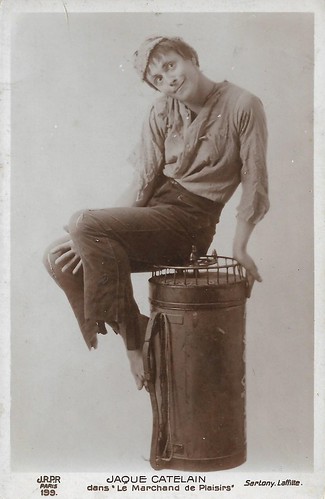
French postcard by J.R.P.R., Paris, no. 199. Jaque Catelain in Le marchand de plaisirs/The Pleasures Merchant (Jaque Catelain, 1923). Photo: Sartony, Lafitte. This was one of two films Catelain directed himself, in addition to his prolific career as a silent film actor.
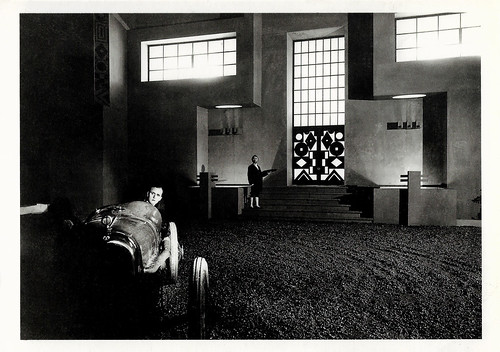
French postcard in the Collection Magie Noire by Editions Hazan, no. 6073, 1988. Photo: Madame L'Herbier / SPADEM, Paris. Jaque Catelain in L'inhumaine/The New Enchantment (Marcel L'Herbier, 1924). The exterior of the house of inventor Einar Norsen (Catelain) was designed by architect Robert Mallet-Stevens.
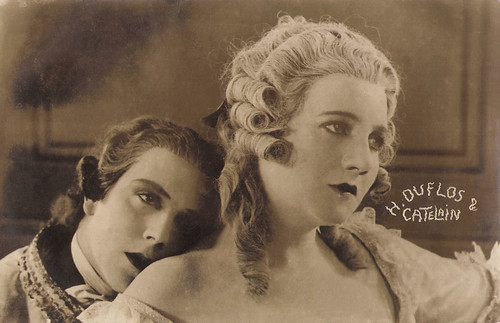
Vintage postcard. Huguette Duflos and Jaque Catelain in Der Rosenkavalier (Robert Wiene, 1925).
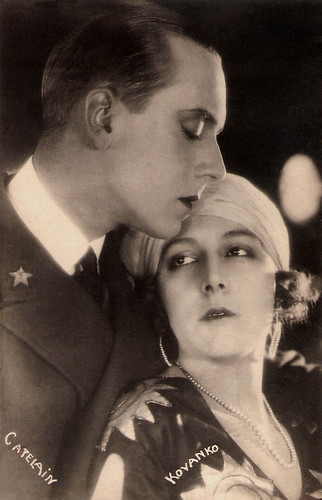
French postcard. With Nathalie Kovanko.

French postcard. Jaque Catelain and Nathalie Kovanko in Le prince charmant/Prince Charming (Viktor Tourjansky 1925).

French postcard by Cinémagazine-Edition, no. 525. Jaque Catelain in Die Apachen von Paris/Paname... n'est pas Paris/Apaches of Paris (Nikolai Malikoff, 1927). Signed by Catelain in 1929.
Good looks of a rather bland and pretty kind
He starred in 12 of the silent films of avant-garde master L'Herbier, including L'homme du large/Man of the Sea (Marcel L'Herbier, 1920) with the young Charles Boyer, Eldorado (Marcel L'Herbier, 1921), L'Inhumaine/The New Enchantment (Marcel L'Herbier, 1924) and Feu Mattia Pascal/The Late Mathias Pascal (Marcel L'Herbier, 1924).
According to Wikipedia, his good looks were of a rather bland and pretty kind which did not commend him so much to later audiences, and he was often criticised for wooden and inexpressive performances. Some contemporary critics, however, notably Louis Delluc, saw his restrained and economical technique as a significant development away from the exaggerated theatrical acting that was still common in films and praised the sincerity and natural quality of his performances.
Catelain not only acted in L'Herbier's films, but he also devised controversial make-up for some of the actors in L'Inhumaine, and his artistic skills were put to further use in two set designs for L'Argent. These films made Catelain into a leading star who was in demand to appear in foreign films as well as in productions of other French directors such as Léonce Perret's lavish production Koenigsmark/The Secret Spring (Léonce Perret, 1923) with Huguette Duflos.
In 1922 he was working in Munich under contract with a German film company and he returned there in 1925 to appear in Robert Wiene's (silent) production of Der Rosenkavalier (1925). Also in 1925, he was offered a seven-year contract by MGM to work in America, but he turned this down.
Under the aegis of L'Herbier's production company Cinégraphic, he directed two silent films himself: Le marchand de plaisirs/The Pleasures Merchant (Jaque Catelain, 1923), shot at Le Touquet, and La galerie des monstres/Gallery of Monsters (Jaque Catelain, 1924) with Jean Murat, shot in Spain.

German postcard by Ross Verlag, Berlin, no. 1805/2, 1927-1928. Photo: Ufa. Publicity still for Die Apachen von Paris/The Apaches of Paris (Nikolai Malikoff, 1927).
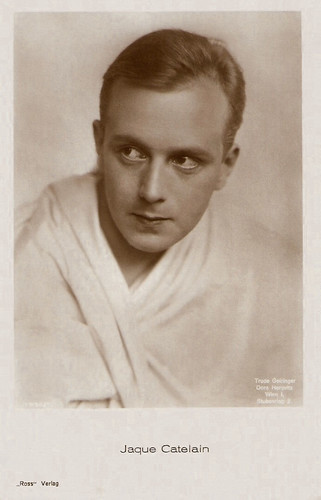
German postcard by Ross Verlag, Berlin, no. 1936/1, 1927-1928. Photo: Trude Heiringer, Dora Horovitz, Wien (Vienna).

German postcard by Ross Verlag, Berlin, no. 3611/1, 1928-1929. Photo: Manuel Frères, Paris.

French postcard by J.R.P.R., Paris, no. 455. Photo: Studio G.L. Manuel Frères.
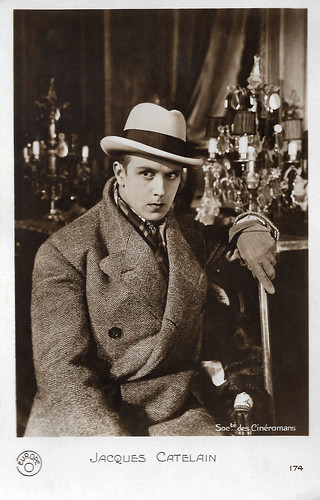
French postcard by Europe, no. 174. Photo: Société des Cinéromans.
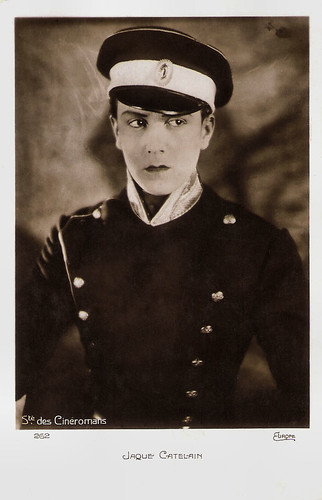
French postcard by Europe, no. 262. Photo: Société des Cinéromans.
Reporter in Hollywood
With the advent of sound, Jaque Catelain first continued to play leads, mostly in L'Herbier's early sound films. After L'Herbier's La Route Imperiale/The Imperial Road (Marcel L'Herbier, 1935) with Käthe von Nagy. Catelain continued to play, e.g. in Jean Renoir's La Marseillaise/The Marseillaise (1938) with Pierre Renoir, but his parts became smaller.
More and more he worked on the stage. In the late 1930s, he was also sent to Hollywood as a reporter for the French Daily Journal, to interview Charlie Chaplin, Josef von Sternberg and Erich von Stroheim. At about the same time Catelain married Suzanne Vial, a friend since childhood who had become a production assistant to L'Herbier in the 1920s and continued working with him until 1944.
In May 1940, Catelain left France for a four-month theatrical tour of South America, but within a month France was occupied by the Germans and his absence lasted for six years. He worked as a stage actor in Montreal and dubbed films for MGM in Hollywood.
After the liberation, he found only bit parts in American films. In 1946, back in France he only played minor roles in films by L'Herbier such as Les derniers jours de Pompeii/The Last Days of Pompeii (Marcel L'Herbier, Paolo Moffa, 1950). Bit parts (partly uncredited) followed in films by Jean Renoir, French CanCan/Only the French Can (Jean Renoir, 1954), Elena et les hommes/Elena and Her Men (Jean Renoir, 1956) and the TV film Le Testament du Dr. Cordelier/The Doctor's Horrible Experiment (Jean Renoir, 1959).
In 1950, Catelain published a book on his 'mentor', Marcel L'Herbier. Jaque Catelain died in 1965, Paris, France. He was the husband of the editor and stage manager Suzanne Vial.
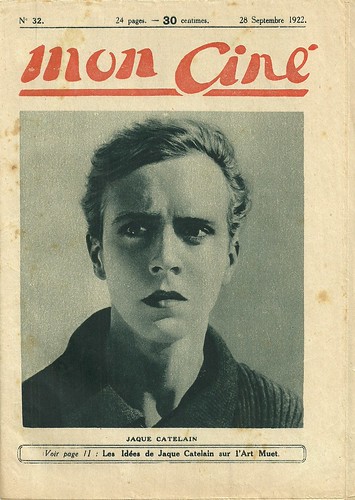
The original cover of the French film journal Mon Ciné, no. 32, 28 September 1922.
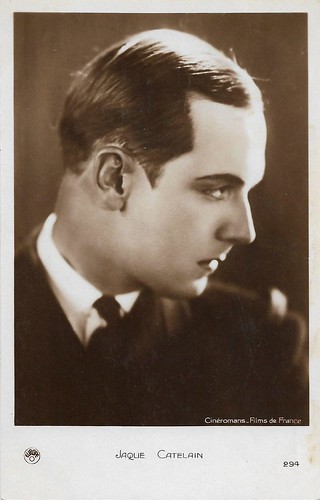
French postcard by Europe, no. 294. Photo: Cinéromans-Films de France.

French postcard by Cinémagazine-Edition, no. 543. Jaque Catelain and Ruth Weyher in Paname...n'est pas Paris/Die Apachen von Paris (Nikolai Malikoff, 1927), a Franco-German co-production, distributed by Ufa.
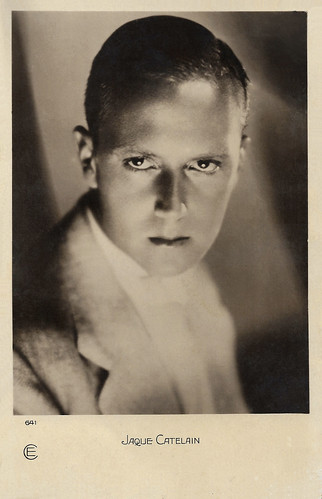
French postcard by Cinémagazine-Edition, no. 641.
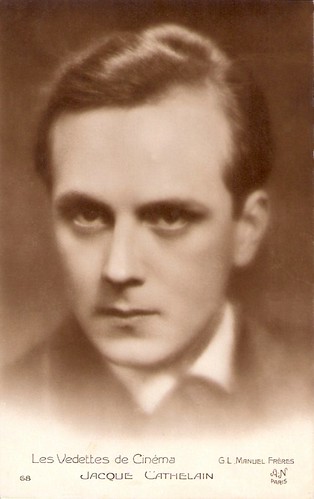
French postcard by A. N., Paris, in the series 'Les vedettes de Cinema', no. 68. Photo: G.L. Manuel Frères.

French postcard by A.N., Paris, no. 347. Photo: Alban.

Austrian postcard by Iris Verlag, no. 444. Photo: Ernst Förster, Vienna.

German autograph card, signed in 1932. Photo: Sandau Brauer, Berlin. Collection: Didier Hanson.
Sources: Thomas Staedeli (Cyranos), 1895, Wikipedia, and IMDb.
This post was last updated on 4 September 2023.
No comments:
Post a Comment